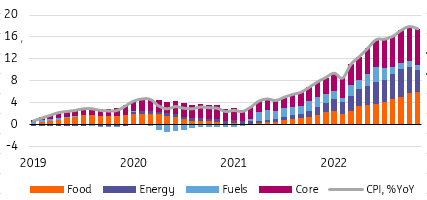Poland: November CPI revised up to 17.5% on energy prices
The flash estimate showed CPI at 17.4% year-on-year but this has been revised up slightly. The Stat office originally reported a small drop in energy prices while the final reading showed them stabilising on a monthly basis. We estimate that the core inflation rate, excluding food and energy prices, rose from 11.0% to 11.4% YoY in November
The main reason for the decline in annual dynamics relative to October (17.9% YoY) was the stabilisation of prices from energy carriers, while in November 2021 we saw a marked month-on-month increase. This year, local governments sold subsidised imported coal at around PLN 2,000 per ton. In addition, fuel prices at gas stations dropped in November. At the same time, food prices continued to rise at a solid pace. And upward pressure on core inflation continued. Based on today's data, we estimate that core inflation, which excludes food and energy prices, rose from 11.0% to 11.4% YoY in November. There was also a marked increase in communications prices (1.2% MoM).
CPI structure in Poland
Lower energy, but core continues to rise.

The final months of 2022 have brought some softening in inflation trends at the headline level, but do not change the unfavourable outlook. The peak of inflation is still ahead - next February, inflation will reach a local peak near 21% YoY. Moreover, core inflation remains on an upward trend. Also, the beginning of the new year may bring an update on a number of prices, including food, and some regulated prices (waste collection, etc.).
From a monetary policy standpoint, the pace of disinflation after the February peak and the outlook for 2024 will be key. In our view, core inflation will remain stubbornly high in 2023 (continuing secondary effects from energy price increases for businesses). We are concerned that despite disinflation at the end of 2023, prices will continue to rise at double-digit rates. In addition, the freezing of electricity and gas prices in 2022 results in a significant inflationary overhang in energy carrier prices. We expect the gap between market wholesale prices and regulated retail prices to be significant enough to require strong tariff increases in 2024.
Our inflation scenario leaves no room for interest rate cuts in the medium term, so we see a stabilisation of rates as the most likely development. We see a number of upside risks to consumer prices, including the potential risk of renewed commodity price growth in 2023 after the opening of the Chinese economy. On the other hand, a deeper-than-expected downturn could limit the ability to pass on higher costs to retail prices.
This publication has been prepared by ING solely for information purposes irrespective of a particular user's means, financial situation or investment objectives. The information does not constitute investment recommendation, and nor is it investment, legal or tax advice or an offer or solicitation to purchase or sell any financial instrument. Read more
Tags
Poland CPIDownload
Download snap